Vrchlabí
Vrchlabí (Czech pronunciation: [ˈvr̩xlabiː]; German: Hohenelbe; Latin: Albipolis) is a town in Trutnov District in the Hradec Králové Region of the Czech Republic. It has about 12,000 inhabitants. It lies at the foot of the Krkonoše mountains, on the upper part of the river Elbe.
Vrchlabí | |
|---|---|
Town | |
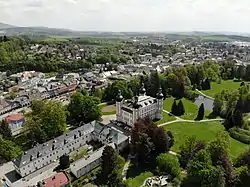 Aerial view of Vrchlabí with the Vrchlabí Castle in the middle | |
 Flag  Coat of arms | |
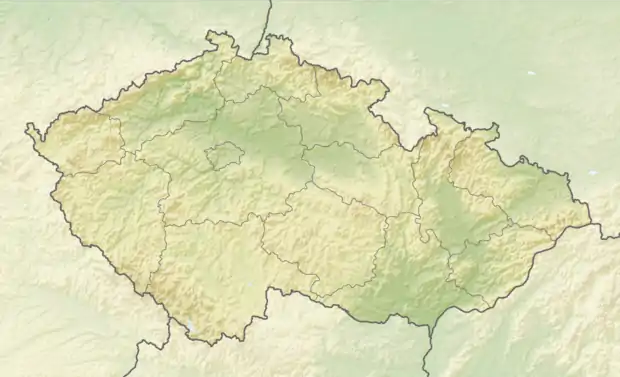 Vrchlabí Location in the Czech Republic | |
| Coordinates: 50°37′40″N 15°36′37″E | |
| Country | |
| Region | Hradec Králové |
| District | Trutnov |
| First mentioned | 1359 |
| Town rights | 1533 |
| Government | |
| • Mayor | Jan Sobotka |
| Area | |
| • Total | 27.66 km2 (10.68 sq mi) |
| Elevation | 477 m (1,565 ft) |
| Population (2020-01-01[1]) | |
| • Total | 12,340 |
| • Density | 450/km2 (1,200/sq mi) |
| Time zone | UTC+1 (CET) |
| • Summer (DST) | UTC+2 (CEST) |
| Postal code | 543 01 |
| Website | www |
Administrative parts
Vrchlabí is divided into:
- Vrchlabí 1 – the centre of the town
- Vrchlabí 3 – village of Podhůří and the area of Liščí Kopec
- Vrchlabí 4 – the upper part of the town, including Kněžice, Třídomí, Upper Herlíkovice
Etymology
The name of the town is closely related with the location on the river Elbe, the oldest name is latin Albipolis (Albi = Labe = The Elbe, Polis = City). Both Czech and German name can be translated as Upper Elbe Area.[2]
History
The history of Vrchlabí started with the settlement of the Krkonoše Mountains (the Giant Mountains) – the highest Czech mountain range. The first settlement called Wrchlab was probably founded before 1300.[2] It was granted town rights in 1533, along with two annual fairs.[2] The most significant person in the history of the town was Kryštof Gendorf, a mining expert who developed the town into one of the most important metallurgy centres.[2] Many people from German speaking lands came to work and live to the town during his reign and brought in the Lutheran reformation faith, which spread quickly in the region, supported vividly by Gendorf himself. Vrchlabí also became a place of fairs at that time. Especially linen cloth was highly desired and it was exported into Italy or Spain, as well North Africa.[2]
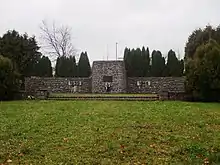
The town was part of the Bohemian (Czech) Kingdom, which itself fell to the Habsburg Monarchy in the 16th century, and from 1867 to 1918 was included in the Austrian part of Austria-Hungary (after the Austro-Hungarian Compromise of 1867). Administratively it was part of the head of the Hohenelbe district, one of the 94 Bezirkshauptmannschaften in Bohemia.[3]
In 1918 it became part Czechoslovakia, when the Czechs regained independence. From 1938 to 1945 it was occupied by Germany, and was then administered as one of the municipalities in Sudetenland. During the occupation, the Germans established and operated a Gestapo prison in the town,[4] and a subcamp of the Gross-Rosen concentration camp for female prisoners in the Hořejší Vrchlabí district.[5] Nazi Germany also brought many Italian, French, English and Russian prisoners of war to work as forced laborers in the town.[6] The town's Germans who had not fled in World War II were expelled according to the Potsdam Agreement and Beneš decrees. The town was restored to Czechoslovakia. The town has flourished economically since the Velvet Revolution in 1989 and has become an important tourist resort.
Economy
The town was a centre of metallurgy in the 15th century. In the 16th century textiles were produced in the town. Manufacturing of organs was introduced into the town by the Tauchmann family.[7] In 1876, winter sports started to develop in the region. One promoter of skiing was Guido Rotter, a local factory owner and the president of Austrian Ski Federation (ÖSV). Nowadays, winter sports comprises one of the most profitable sectors of the town's economy, along with the tourism industry and automotive industry, which is represented by the Škoda Auto factory.
Sights
The centre of the town is historically significant and since 1990 is protected by law as Urban monument zone.
Culture
In Vrchlabí there are many events, such as Krkonošské pivní slavnosti, Turistický pochod, Krakonošova stovka or Dny řemesel that are held every year. The Střelnice house is the centre of culture.[8] It is a place where all concerts, plays or balls are performed.
Sport
A local ice hockey club, HC Vrchlabí, plays in the 1st Czech Republic Hockey League (2nd tier of the Czech ice hockey league system) since 2020–21 season.
Notable people
- Victor Kugler (1900–1989), Austrian-Dutch war hero
- Anna K (born 1965), singer
- Zdeněk Vítek (born 1977), biathlete and coach
- Veronika Vítková (born 1988), biathlete
- Michal Krčmář (born 1991), biathlete
- Karolína Erbanová (born 1992), long-track speed skater
- Eva Samková (born 1993), snowboarder, Olympic champion
Twin towns – sister cities
 Baunatal, Germany
Baunatal, Germany Kowary, Poland
Kowary, Poland Trouville-sur-Mer, France
Trouville-sur-Mer, France
References
- "Population of Municipalities – 1 January 2020". Czech Statistical Office. 2020-04-30.
- "Historie" (in Czech). Město Vrchlabí. Retrieved 2020-09-03.
- Die postalischen Abstempelungen auf den österreichischen Postwertzeichen-Ausgaben 1867, 1883 und 1890, Wilhelm Klein, 1967
- "Gestapogefängnis Hohenelbe". Bundesarchiv.de (in German). Retrieved 10 September 2020.
- "Subcamps of KL Gross- Rosen". Gross-Rosen Museum in Rogoźnica. Retrieved 10 September 2020.
- Dorota Sula, Jeńcy włoscy na Dolnym Śląsku w czasie II wojny światowej, "Łambinowicki rocznik muzealny" Tom 33, Opole, 2010, p. 66 (in Polish)
- Tomíček, J. (2010). Varhany a jejich osudy. Kapitola Varhanářská manufaktura ve Vrchlabí. PM Vydavatelství.
- Culture, Sport and free time. Retrieved November 30, 2012, from http://www.muvrchlabi.cz/cz/kultura-sport-volny-cas/
- "Partnerská města" (in Czech). Město Vrchlabí. Retrieved 2020-09-03.
External links
 Media related to Vrchlabí at Wikimedia Commons
Media related to Vrchlabí at Wikimedia Commons- Official website

- Information about Vrchlabí in the Krkonoše Mountains
- Information about the 1938–1945 history (in German)
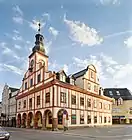
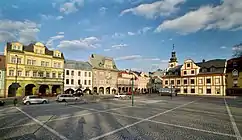
.jpg.webp)
